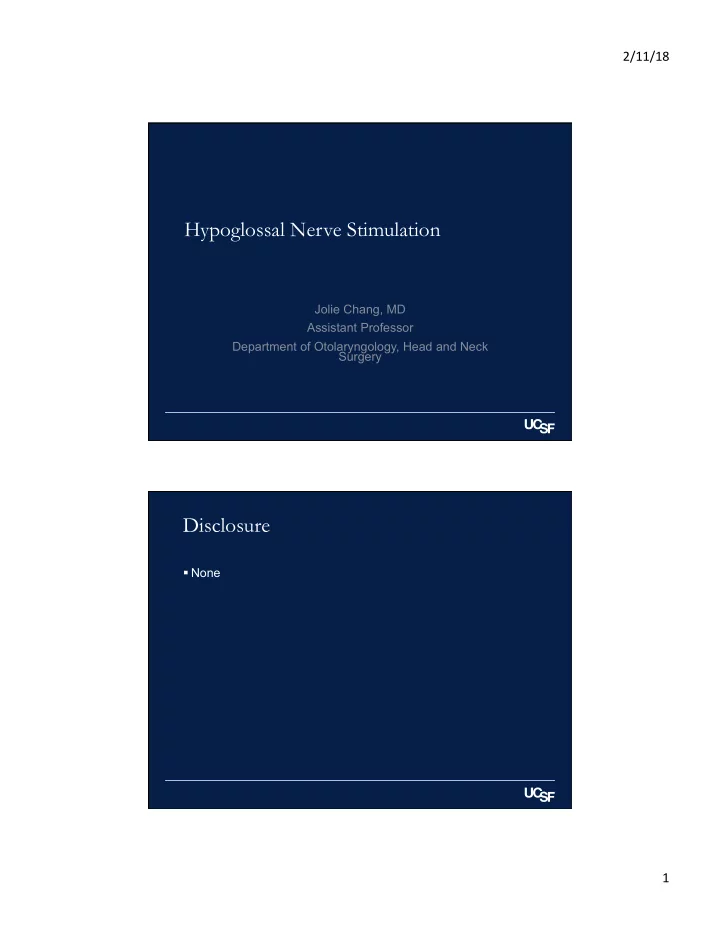

2/11/18 Hypoglossal Nerve Stimulation Jolie Chang, MD Assistant Professor Department of Otolaryngology, Head and Neck Surgery Disclosure § None 1
2/11/18 Outline § HNS Development § WHO: Current clinical criteria for HGNS § HOW: Surgical procedure and technique § WHY: Effectiveness of therapy § Future directions OSA § 60-90% patients have multi- level collapse § DISE used to identify major sites of collapse 2
2/11/18 Upper Airway Muscles in Sleep § Increased Collapsibility • Anatomy • Neuromuscular Control § Genioglossus = UA dilator • Improves upper airway patency • GGEMG declines in sleep – worse in OSA • Activation improves airflow and OSA Genioglossus stimulation § Animal • Electrical stimulation of GG restores airway patency in sleep § Human • GG stimulation associated with ‒ Increased maximum inspiratory airflow, without arousals ‒ Enlargement of retrolingual and retropalatal airway • Distal and proximal hypoglossal nerve stimulation can open airway and improve airflow Schwartz Ar, et al. J. Appl Physiol. 1996. 3
2/11/18 Pcrit § Genioglossus contraction improves upper airway patency Oliven A, et al. J Appl Physiology. Feb 2003. Stimulation systems § Feasibility trials Schwartz et al. J Appl Physiol 2013. 4
2/11/18 Hypoglossal Nerve Stimulation § FDA approved first device – Inspire II 4/2014 § Fully implanted system with sleep remote § Unilateral (right) Hypoglossal Nerve stimulation § Synchronized to inspiration Clinical Evidence § STAR Trial: Strollo et al. NEJM 2014. § 126 patients with mod-severe OSA § 12-months post implant § Reduced: • AHI (29.3 to 9) 68% • ODI (25.4 to 7.4) • ESS survey • FOSQ survey • Daily use: 86% 5
2/11/18 3-year Data AHI 35.0 29.3 30.0 Median AHI 25.0 20.0 15.0 9.7 9.0 10.0 6.2 5.0 0.0 Baseline 12 Month 18 Month 36 Month N=126 N=124 N=121 N=98 Gillespie et al. Otolaryngology-HNS. 2017. Compliance and ESS Gillespie et al. Otolaryngology-HNS. 2017. 6
2/11/18 Clinical Indications for HGNS § Patient goals and expectations § CPAP intolerance § BMI < 35 § PSG: AHI 15 to 65 • <25% Central apnea § Appropriate airway anatomy: DISE • Rule out complete concentric collapse at the palate § Considerations: • MRI needs • Medical history • Surgical history: Prior implants, prior breast surgery Preoperative evaluation DISE § Rule out complete concentric collapse at soft palate § Vanderveken et al. J Clin Sleep Med 2013: • 21 pts – predictive value of DISE for HGNS outcomes • 16 pts without palate CCC: AHI 38 to 12 • 5 pts with CCC: no change in postop AHI 7
2/11/18 Intraoperative – Hypoglossal Nerve § NIMS electrodes § Goal: unhindered tongue PROTRUSION and STIFFENING § Include nerve branches for: • Protrusion = oblique and horizontal genioglossi (GG) • Stiffen = intrinsic transverse/vertical (TV) • C1 = geniohyoid (if possible) § Exclude • Retrusion = hyoglossus, styloglossus (HG, SG) NIMS § 18mm paired electrodes § Genioglossus: Floor of mouth § Hyoglossus: lateral tongue 8
2/11/18 Styloglossus (SG) Hypoglossal Nerve Hyoglossus (HG) § Proximal lateral branches innervate retrusors • Hyoglossus Geniohyoid (GH) S"mula"on Site Genioglossus (GG) • Styloglossus Retractor Muscles Protrusor Muscles § Distal, medial branches innervate protrusors • Genioglossus • Intrinsic T/V § C1 to geniohyoid Dedhia et al. Neuroanatomy of the tongue. Hypoglossal Nerve 9
2/11/18 Electrode placement 10
2/11/18 System Validation Postoperative Care § Reduced postoperative pain and medication use § Reduced postoperative hospital stay § CXR § Precautions: no excessive right arm motion, no heavy lifting x 2 weeks § Dressings off POD #2 11
2/11/18 Activation and Acclimation § 1 month postop § Thresholds • Sensation • Discomfort § Activation Range provided § Patient self titrates over 1 month § Therapy works by balancing functional threshold with arousal threshold and comfort PSG at 2 months 12
2/11/18 DISE Awake Laryngoscopy with Stimulation 13
2/11/18 New Devices – Selective Nerve Stimulation § ImThera Medical (Aura6000)- Trial § Current Phase III trial § No DISE requirement § 6 electrodes, circum OSA Surgery Treatment Paradigm § Address anatomic causes of obstruction • Palatine and Lingual Tonsils • Soft palate: UPPP • Parapharyngeal fat, macroglossia: Weight • Epiglottis: epiglottectomy, hyoid suspension, HGNS? • Retrognathia: MMA § HGNS to improve neuromuscular tone in sleep § Patients choice and shared decision making 14
2/11/18 HGNS Advantages § Addresses reduced neuromuscular tone in OSA § Can be titrated to effect and reprogrammed § Excellent safety profile, low morbidity § Reduced post-operatve pain, faster recovery § Provides multi-level therapy § Good patient adherence over time § Good results in properly selected patients Future of HGNS § Transcutaneous continuous stimulation § New devices, stimulation schemes § Questions • Who is the ideal candidate? • What are the long term effects of chronic stim? • Examine the nonresponders § Personalized medicine: How fit into OSA surgery? • Address anatomic causes: tonsils, weight, craniofacial • HGNS for neuromuscular stim • Shared patient decision making 15
Recommend
More recommend